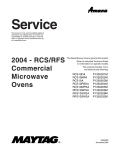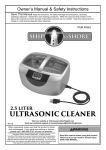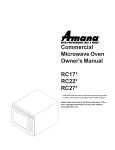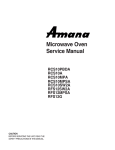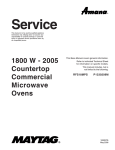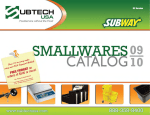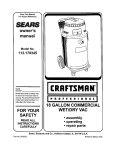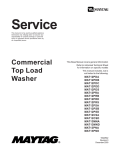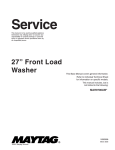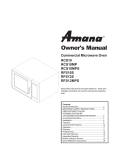Download ACP Microwave Oven Service manual
Transcript
Service technicians only. ACP does not assume any responsibility for property damage or personal injury for improper service procedures done by RCS/RFS Commercial Microwave Ovens This Base Manual covers general information Refer to individual Technical Sheet for information on models This manual includes, but is not limited to the following: RCS10DA RCS10DA RCS10MPA RCS10MPA RCS10A RCS10PBDA RCS10MPSA RCS10MPSA RFS12MPSA RFS12SW2A RFS10SW2A P1330201M P2000702M P1330202M P2000704M P1330203M P1330204M P1330205M P2000705M P1330206M P1330208M P1330232M 16023293 Rev. 1 May 2010 Important Information Important Notices for Servicers and Consumers ACP will not be responsible for personal injury or property damage from improper service procedures. Pride and workmanship go into every product to provide our customers with quality products. It is possible, however, that during its lifetime a product may require service. Products should be serviced only by a service technician who is familiar with the safety procedures required in the repair and who is equipped with the proper tools, parts, testing instruments and the appropriate service information. IT IS THE TECHNICIANS RESPONSIBLITY TO REVIEW ALL APPROPRIATE SERVICE INFORMATION BEFORE BEGINNING REPAIRS. ! WARNING To avoid risk of severe personal injury or death, disconnect power before working/servicing on appliance to avoid electrical shock. To locate an authorized servicer please contact: ComServ Support Center Web Site WWW.ACPSOLUTIONS.COM ....................... Telephone Number 1-866-426-2621 or 319-368-8195 E-Mail: [email protected] Recognize Safety Symbols, Words, and Labels ! DANGER DANGER— Immediate hazards which WILL result in severe personal injury or death. ! WARNING WARNING— Hazards or unsafe practices which COULD result in severe personal injury or death. ! CAUTION CAUTION— Hazards or unsafe practices which COULD result in minor personal injury, product or property damage. 2 16023293 Rev. 0 ©2010 ACP, Inc. Table of Contents Important Information .................................................... 2 Important Safety Information ........................................ 4 Grounding Instructions ............................................... 7 Servicing of Grounded Products ............................ 8 Wiring ................................................................................. 8 Proper Grounding and Polarization of 120 Volts Wall Outlets ............................................ 8 Explanation ..................................................................... 8 Test Procedures ..................................... ................... 8 General Test Information ............................................ 8 General Information Unpacking Equipment ................................................ 9 Equipment Placement ............................................... 9 Radio Interference ...................................................... 9 Oven Features ........................................................... 9 Model Identification ................................................... 10 Service ...................................................................... 10 Parts and Accessories .................................................... 10 Troubleshooting Procedures .................................. 11-16 Testing Procedures ................................................. 20-23 Power Test................................................................ 24 ©20 10 ACP, Inc. Disassembly Procedures Disconnecting Wire Terminals .................................. 25 Outer Case ............................................................... 25 Door Assembly ...............................................................26 Door Disassembly ...................................................26 Control Panel Removal......................................................27 Interlock Switches ......................................................... 27 H.V. Capacitor .................................................................. 28 Diode ........................................................................ 28 Transformer ............................................................. 29 Fuse / Fuse Block /Filter Assembly ........................ 29 Magnetron ......................................................................... 29 Blower Motor or Wheel .................................................. 30 Splatter Shield .........................................................30 Antenna ...................................................................... 30 Stirrer M otor ..................................................................... 30 Magnetron Thermal Cut-Out (TCO) ........................... 31 Cavity Thermal Fuse ................................................. 31 ..................................................... 31 Tray Replacement Oven Light Removal .................................................. 31 Appendix A Quick Reference Guide Dial Model ......................... A-2 Quick Reference Guide Digital Dial Model ............. A-3 Quick Reference Guide Electronic Model ............... A-5 16023293 Rev. 0 3 Important Safety Information ! WARNING Read the following information to avoid possible exposure to microwave radiation: The basic design of the Microwave Oven makes it an inherently safe device to both use and service. However, there are some precautions which should be followed when servicing the Microwave Oven to maintain this safety. These are as follows: 1. Always operate the unit from an adequately grounded outlet. Do not operate on a two-wire extension cord. 8. Do not for any reason defeat the interlock switches there is not a valid reason for this action at anytime; nor will it be condoned by ACP. 2. Before servicing the unit (if unit is operable) perform the microwave leakage test. 9. IMPORTANT: Before returning a unit to a customer, be sure to check for proper switch interlock action. 3. The oven should never be operated if the door does not fit properly against the seal, the hinges or hinge bearings are damaged or broken; the choke is damaged, (pieces missing, etc.); or any other visible damage can be noted. Check the choke area to ensure that this area is clean and free of all foreign matter. 4. If the oven operates with the door open and produces microwave energy, take the following steps: A. Tell the user not to operate the oven. B. Contact ACP immediately. 5. Always have the oven disconnected when the outer case is removed except when making the "live" tests called for in this Service Manual. Do not reach into the equipment area while the unit is energized. Make all connections for the test and check them for tightness before plugging the cord into the outlet. 6. Always ground the capacitors on the magnetron filter box with an insulated-handle screwdriver before working in the high voltage area of the equipment compartment. Some types of failures will leave a charge in these capacitors and the discharge could cause a reflex action which could make you injure yourself. 10. Before returning a unit to a customer, verify that the door spacing is reasonably uniform along the top, bottom, and sides, and that it measure 1/64"/0.5mm or less. 11. Microwave ovens should never be operated with any components removed and/or bypassed or when any of the safety interlocks are found to be failing or when any of the seal surfaces are failing, missing or damaged. 12. All microwave ovens meet all requirements of the radiation control for Health and Safety Act of 1968. Due to measurement uncertainties, the maximum leakage for the field will be 4mw/cm2. 13. To ensure that the unit does not emit excessive microwave leakage and to meet the Department of Health and Human Services guidelines, check the oven for microwave leakage using a leakage monitor. The maximum leakage level allowed when following those instructions is 4mw/cm2. 14. If servicer encounters an emission reading over 4mw/cm2, the servicer is to cease repair and contact the Commercial Support Center immediately for further direction. ACP will contact the proper Government Agency upon verification of the test results. 7. Always remember that in the area of the transformer there is HIGH VOLTAGE. When the unit is operating keep this area clear and free of anything which could possibly cause an arc or ground, etc. 4 16023293 Rev. 0 ©2010 ACP, Inc. Important Safety Information Recognize this symbol as a SAFETY message ! WARNING When using electrical equipment, basic safety precautions should be followed to reduce the risk of burns, electrical shock, fire, or injury to persons. 1. READ all instructions before using equipment. 2. READ AND FOLLOW the specific “PRECAUTIONS TO AVOID POSSIBLE EXPOSURE TO EXCESSIVE MICROWAVE ENERGY”. 3. This equipment MUST BE GROUNDED. Connect only to properly GROUNDED outlet. See “GROUNDING INSTRUCTIONS”. 4. Install or locate this equipment ONLY in accordance with the installation instructions in this manual. 5. Some products such as whole eggs and sealed containers, for example, closed glass jars may explode and SHOULD NOT be HEATED in this oven. 6. Use this equipment ONLY for its intended use as described in this manual. Do not use corrosive chemicals or vapors in this equipment. This type of oven is specifically designed to heat or cook. It is not designed for industrial or laboratory use. 7. As with any equipment, CLOSE SUPERVISION is necessary when used by CHILDREN. 8. DO NOT operate this equipment if it has a damaged cord or plug, if it is not working properly, or if it has been damaged or dropped. 9. This equipment, including power cord, must be serviced ONLY by qualified service personnel. Special tools are required to service equipment. Contact nearest authorized service facility for examination, repair, or adjustment. 10. DO NOT cover or block filter or other openings on equipment. 11. DO NOT store this equipment outdoors. DO NOT use this product near water, for example, near a kitchen sink, in a wet basement, or near a swimming pool, and the like. 12. DO NOT immerse cord or plug in water. 13. Keep cord AWAY from HEATED surfaces. 14. DO NOT let cord hang over edge of table or counter. 15. See door cleaning instructions in “Care and Cleaning” section. 16. For commercial use only. ! CAUTION To reduce risk of fire in the oven cavity: a. DO NOT overcook food. Carefully attend equipment if paper, plastic, or other combustible materials are placed inside the oven to facilitate cooking. b. Remove wire twist-ties from paper or plastic bags before placing bag in oven. c. KEEP oven DOOR CLOSED, turn oven off, and disconnect the power cord, or shut off power at the fuse or circuit breaker panel, if materials inside the oven should ignite. Fire may spread if door is opened. d. DO NOT use the cavity for storage. DO NOT leave paper products, cooking utensils, or food in oven. SAVE THESE INSTRUCTIONS ©2010 ACP, Inc. 16023293 Rev. 0 5 Important Safety Information ! CAUTION To avoid risk of personal injury or property damage, observe the following: 1. Briskly stir or pour liquids before heating with microwave energy to prevent spontaneous boiling or eruption. Do not overheat. If air is not mixed into a liquid, liquid can erupt in oven or after removal from oven. 7. Do not use regular cooking thermometers in oven. Most cooking thermometers contain mercury and may cause an electrical arc, malfunction, or damage to oven. 8. Do not heat baby bottles in oven. 2. Do not deep fat fry in oven. Fat could overheat and be hazardous to handle. 3. Do not cook or reheat eggs in shell or with an unbroken yolk using microwave energy. Pressure may build up and erupt. Pierce yolk with fork or knife before cooking. 4. Pierce skin of potatoes, tomatoes, and similar foods before cooking with microwave energy. When skin is pierced, steam escapes evenly. 5. Do not operate equipment without load or food in oven cavity. 6. Use only popcorn in packages designed and labeled for microwave use. Popping time varies depending on oven wattage. Do not continue to heat after popping has stopped. Popcorn will scorch or burn. Do not leave oven unattended. 9. Do not use metal utensils in oven. 10. Never use paper, plastic, or other combustible materials that are not intended for cooking. 11. When cooking with paper, plastic, or other combustible materials, follow manufacturer's recommendations on product use. 12. Do not use paper towels which contain nylon or other synthetic fibers. Heated synthetics could melt and cause paper to ignite. 13. Do not heat sealed containers or plastic bags in oven. Food or liquid could expand quickly and cause container or bag to break. Pierce or open container or bag before heating. 14. To avoid pacemaker malfunction, consult physician or pacemaker manufacturer about effects of microwave energy on pacemaker. PRECAUTIONS TO AVOID POSSIBLE EXPOSURE TO EXCESSIVE MICROWAVE ENERGY a. DO NOT attempt to operate this oven with the door open since open-door operation can result in harmful exposure to microwave energy. It is important not to defeat or tamper with the safety interlocks. c. DO NOT operate the oven if it is damaged. It is particularly important that the oven door close properly and that there is no damage to the: (1) door (bent), (2) hinges and latches (broken or loosened), (3) door seals and sealing surfaces. b. DO NOT place any object between the oven front face and the door or allow soil or cleaner residue to accumulate on sealing surfaces. d. The oven should NOT be adjusted or repaired by anyone except properly qualified service personnel. SAVE THESE INSTRUCTIONS 6 16023293 Rev. 0 ©2010 ACP, Inc. Important Safety Information ! Grounding Instructions WARNING Precautions to be observed before and during servicing to avoid possible exposure to excessive microwave energy, or electrical shock disconnect power to oven. • Do not operate or allow oven to be operated with door open. • Make the following safety checks on all ovens to be serviced before activating the magnetron or other microwave source, and make repairs as necessary: • Interlock operation • Proper door closing • Seal and sealing surfaces (arcing, wear, and other damage) • Damage to or loosening of hinges and latches • Evidence of dropping or abuse • Before turning on microwave power for any service test or inspection within the microwave generating compartments, check the magnetron, waveguide or transmission line, and cavity for proper alignment, integrity, and connections. • Any failed or misadjusted components in the interlock, monitor, door seal, and microwave generation and transmission systems shall be repaired, replaced or adjusted by procedures described in this manual before oven is released to the consumer. • Check microwave leakage to verify compliance with the federal performance standard should be performed on each oven prior to release to the consumer. ! WARNING To avoid risk of electrical shock, injury or death; make sure these grounding instructions are followed. ! Do not remove grounding prong when installing grounded appliance in a home or business that does not have three wire grounding receptacle, under no condition is grounding prong to be cut off or removed. It is the personal responsibility of the consumer to contact a qualified electrician and have properly grounded three prong wall receptacle installed in accordance with appropriate electrical codes. ! WARNING To avoid the risk of electrical shock or death, do not alter the plug. ! WARNING To avoid the risk of electrical shock or death, this equipment must be grounded. This equipment MUST be grounded. In the event of an electrical short circuit, grounding reduces the risk of electric shock by providing an escape wire for the electric current. This oven is equipped with a cord having a grounding wire with a grounding plug. The plug must be plugged into an outlet that is properly installed and grounded. Consult a qualified electrician or servicer if grounding instructions are not completely understood, or if doubt exists as to whether the equipment is properly grounded. Do not use an extension cord. If the product power cord is too short, have a qualified electrician install a threeslot receptacle. This oven should be plugged into a separate 60 hertz circuit with the electrical rating as shown in the appropriate drawing. Models operate with a 120 supply voltage. When a microwave oven is on a circuit with other equipment, an increase in cooking times may be required and fuses can be blown. NEMA 5-15R/5-15P 120V–15AMP NEMA 5-20R/5-20P 120V–20AMP ©2010 ACP, Inc. WARNING 16023293 Rev. 0 7 Important Safety Information Servicing of Grounded Products Explanation The standard accepted color coding for grounding wires is GREEN or GREEN WITH YELLOW STRIPE. These ground leads are NOT to be used as current carrying conductors. It is extremely important that the technician replace any and all grounds prior to completion of the service call. Under no condition should ground wire be left off causing a potential hazard to technicians and consumer. Polarization –This means that the larger slot must be neutral and the small slot must be hot (live). Mispolarized –The outlet is miswired so that the larger slot is hot (live) and the smaller slot is neutral. Grounded –This means the round hole connection is connected to earth ground through a connection to the main power panel. Ungrounded –The round hole connection is not complete to earth ground and/or the main power panel. Wiring A good service practice is never route wiring over terminals and/ or sharp edges. This applies to any wiring without regard to the circuit voltage. Wire installation material and thickness is designed and regulated for electrical spacing purpose only, but cannot always be relied upon because of possible cuts and/or abrasions, which can occur during servicing. ! WARNING To avoid risk of electrical shock, personal injury or death; verify the oven is properly grounded and polarized. ! CAUTION To avoid risk of electrical shock, personal injury or property damage; wiring changes or grounding of wall outlet are to be made only by a qualified electrician. General Test Information Proper Grounding and Polarization of 120 Volts Wall Outlets For the safety of our customers and the service technician ALL appliances have a three–prong power cord and MUST be connected to a properly polarized and grounded wall outlet. Most testing in the manual is conducted with an ohmmeter using a multiplier scale of X 10k (k–thousand ohms). When using this scale, it is important that your fingers do not touch the metal parts of the test probes. To do so will give a false indication of the ohm reading. This information was written for those who do not understand grounding and polarization of a wall outlet. A 120 volt wall outlet must always be wired as shown below. Neutral (N) - This slot is the larger of the two and should be neutral (dead) with respect to ground. H N Hot (H) - This slot is the smaller size and should always be hot (live) with respect to neutral (N) and ground(G). G Ground (G) - The round hole connection is for the grounding circuit. Behind the cover plate a green wire should be connected to this terminal. 8 16023293 Rev. 0 ©2010 ACP, Inc. General Information Unpacking Equipment Radio Interference • Inspect equipment for damage such as dents in door or dents inside oven cavity. • Report any dents or breakage to source of purchase immediately. Do not attempt to use oven if damaged. • Remove all materials from oven interior. Microwave operation may cause interference to radio, television, or similar equipment. Reduce or eliminate interference by doing the following: Equipment Placement • Do not install equipment next to or above source of heat, such as pizza oven or deep fat fryer. This could cause microwave oven to operate improperly and could shorten life of electrical parts. • Do not block or obstruct air filter. Allow access for cleaning. • Install on level countertop surface. • Clean door and sealing surfaces of oven according to instructions in “Care and Cleaning” section. • Place radio, television, etc. as far as possible from oven. • Use a properly installed antenna on radio, television, etc. to obtain stronger signal reception. Oven Features Removable Splatter Shield (Not Shown) A A Oven Door Window and Interior Light Oven Display A Oven Control Pads Filter A—Allow at least 1½ inches / 3.81 centimeters of clearance around top and sides of equipment. Proper air flow around equipment cools electrical components. With restricted air flow, oven may not operate properly and life of electrical parts is reduced. ©2010 ACP, Inc. 16023293 Rev. 0 9 General Information Model Identification • For ACP product call 1-866-426-2621 or visit the Web Site at www.acpsolutions.com When contacting for service support, provide product information located on rating plate. Record the following: Model Number: Manufacturing Number: Serial or S/N Number: Date of purchase: Dealer’s name and address: ___________________ ___________________ ___________________ ___________________ ___________________ Service Keep a copy of sales receipt for future reference or in case warranty service is required. To locate an authorized servicer: • For ACP product call 1-866-426-2621 or visit the Web Site at www.acpsolutions.com Warranty service must be performed by an authorized servicer. We also recommend contacting an authorized servicer, if service is required after warranty expires. Parts and Accessories Purchase replacement parts and accessories over the phone. To order accessories for your product contact your local product distributor or vist the Web site at www.amanacommercial.com. 10 16023293 Rev. 0 ©2010 ACP, Inc. Troubleshooting Procedures When you get a complaint from customers, evaluate the complaint carefully. If the following symptoms apply, instruct the customer in the proper use of the microwave oven. This can eliminate an unnecessary service call. ! CAUTION • • • • Verify proper earthing before checking for trouble. Be careful of the high voltage circuit. Discharge the high voltage capacitor. When checking the continuity of the switches or of the high voltage transformer, disconnect one lead wire from these parts and then check continuity with the AC plug removed. To do otherwise may result in a false reading or damage to your meter. • Do not touch any part of the circuit on the controller, since static electric discharge may damage the control panel. Always touch yourself to earth while working on this panel to discharge any static charge built up in your body. Condition Microwave oven does not work. Output power is too low. Cause • Inserting multiple plugs into one outlet and using them at the sam e tim e (blown fuse or breaker). • Microwave oven plug is not inserted tightly. • Low AC input voltage. • Food temperature is too low. Sparks occur. Uneven cooking. ©2010 ACP, Inc. • Using metallic ware and allowing it to touch the oven wall. • Ceram ic ware trimmed in gold or silver is used. Inconsistent food thickness, inconsistent fat or moisture distribution within the food products. 16023293 Rev. 0 Remedy • Avoid using other electrical appliances when you use the m icrowave oven. • Insert m icrowave oven plug securely. • Use the m icrowave oven at adequate line voltage. • This may not be a defect. It is possible that the food should be cooked for a longer time period. • Do not use m etallic ware for cooking. • Do not use any type of cookware with metallic trimm ing. • Use plastic wrap or lid. • Stir once or twice while cooking soup, cocoa, milk, etc. 11 Troubleshooting Procedures Trouble 1: The following visual conditions indicate a probable failed control circuit. 1. Incomplete segments. • Segment missing. • Partial segment missing. • Digit flickering (Note: Slight flickering is normal.) 2. Colon does not turn on or blink. 3. A distinct change in the brightness of one or more numbers in display. 4. One or more digits in the display are not lighting. 5. Display indicates a number different from one touched, for example, key in 5 and 3 appears in the display. 6. Specific numbers (for example 7 or 9) will not display when key pad is touched. 7. Display does not count down with time blinking or up with clock operation. 8. Display obviously jumps in time while counting down. 9. Display counts down too fast while cooking. 10.Each indicator light does not turn on after setting cooking cycle. 11. Display time of day does not reappear when cooking is finished. 12 Condition No input can be programmed. Check Check the connection between keypad and controller. Result • Continuity • No continuity 1. Some inputs cannot be programmed. 2. Display shows a number or figure different from one touched. 3. Random programming when touching other pads. 4. Display is fixed at some figure and can not accept any input. Replace keypad and check operation. • Everything works as specified. • Still have trouble. 16023293 Rev. 0 Cause • Failed controller. • Loose connection. • Failed keypad. Remedy • Replace controller. • Repair connection. • Replace keypad. • Failed controller. • Replace controller. ©2010 ACP, Inc. Troubleshooting Procedures (Electronic Models) Trouble 2: Oven does not operate at all, display window does not display any digits, and no input is accepted. Fuse blows. Check continuity of monitor switch with door closed. Continuity Malfunction of the monitor switch. Replace the fuse, primary, secondary, monitor switches and controller. No Continuity Replace fuse Check continuity of primary switch with door opened. Continuity Malfunction of primary switch. No Continuity Check continuity of secondary switch with door opened. Continuity Malfunction of secondary switch. No Continuity Disconnect one side of the wire lead connecting transformer to high voltage capacitor and operate the unit. Fuse blows again. Abnormal Normal Fuse does not blow. Continuity ©2010 ACP, Inc. Measure resistance of high voltage capacitor. Check continuity of thermostat (cavity and magnetron). Check continuity of power cord. No Continuity 16023293 Rev. 0 Replace the fuse, primary, secondary, monitor switches and controller. Failed high voltage transformer. Replace high voltage transformer. Failed high voltage capacitor. Replace high voltage capacitor. Capacitor is good, (replace fuse only). Normal No Continuity Replace the fuse, primary, secondary, monitor switches and controller. Failed thermostat. Failed power cord. Replace thermostat. Replace power cord. 13 Troubleshooting Procedures (Electronic Models) Trouble 3: Display shows all digits programmed, but does not start cooking when the START pad is pressed. Check continuity of secondary switch with door closed. Time does not count down after START pad is pressed. No Continuity Malfunction of secondary switch. Replace the secondary switch. Continuity Check connection between CN1 connector and controller. Continuity Failed controller. Replace controller. No Continuity Loose connection. Repair connection. Normal Fan motor or oven light does not operate. Check fan motor. Abnormal Failed fan motor. Replace fan motor. Check oven light. Abnormal Failed oven light. Replace oven light. Normal 14 16023293 Rev. 0 ©2010 ACP, Inc. Troubleshooting Procedures (Electronic Models) Trouble 4: Output performance is low. Oven operates with little or no heat. Lower than 90% of rated voltage. Check the power supply voltage. Decrease in supply voltage under load. Normal Disconnect wire leads from relay RY2 and verify on and off times. Abnormal Failed controller. Customer must contact local power company or qualified electrician. Replace controller. Normal Measure the output power. Abnormal Failed magnetron Replace magnetron. NOTE: Simple test of power output can be conducted by heating one liter of water for 33 seconds. Refer to Power Test on page 24 of this manual. ©2010 ACP, Inc. 16023293 Rev. 0 15 Troubleshooting Procedures (Electronic Models) Trouble 5: No microwave oscillation even when oven light and fan motor operate. No microwave oscillation. Disconnect wire leads from relay RY2 and verify continuity of the relay. No Continuity Check high voltage transformer. Abnormal Failed controller. Replace controller. Continuity Failed high voltage transformer. Replace high voltage transformer. Failed high voltage capacitor. Replace high voltage capacitor. Normal Check high voltage capacitor. Abnormal Normal Check high voltage diode. Abnormal Failed high voltage diode. Replace high voltage diode. Normal Abnormal Failed magnetron. Abnormal Failed controller. Check magnetron. Operates at full power when programmed for lower power. 16 Disconnect wire leads from relay RY2 and verify continuity of the relay. 16023293 Rev. 0 Replace magnetron. Replace controller. ©2010 ACP, Inc. Testing Procedures ! WARNING To avoid risk of electrical shock, personal injury or death; disconnect power to oven and discharge capacitor before servicing, unless testing requires power. Illustration Component Thermal cutout Testing Disconnect all wires from TCO. Measure resistance across terminals. Cavity TCO............................................ Magnetron TCO..................................... Diode Discharge Capacitor Remove diode lead from capacitor and connect ohmmeter. Capacitor Reverse leads for second test. Discharge Capacitor Remove wires from capacitor terminals and connect ohmmeter, set on highest resistance scale to terminals. Magnetron Also check between each terminal and capacitor case. Discharge Capacitor Remove wires from magnetron and connect ohmmeter to terminals. Also check between each terminal and ground. Blower motor Transformer NOTE: Ohmmeter must contain a battery of 6 volts minimum. Between Terminals: Meter should momentarily deflect towards zero then return to over 5 MΩ. If no deflection occurs, or if continuous deflection occurs, replace capacitor. Terminal to Case: Infinite resistance Between Terminals: Less than 1 Ω Each terminal to ground measures Infinite resistance. Note: This test is not conclusive. If oven does not heat and all other components test good replace the magnetron and retest. Approximately 14 – 21 Ω Remove all wires from motor. Measure resistance across terminals .... Secondary Closed at 32°F (0°C) and Opens at 230°F (110°C) Closed at 140°F (60°C) and Opens at 320°F (160°C) Infinite resistance should be measured in one direction and 50KΩ or more in the opposite direction. Remove all wires from motor. Measure resistance across coil ............. Stirrer motor Results Approximately 3 – 3.5 KΩ Discharge Capacitor Remove all wires from terminals. Filament Primary Noise filter board 6 minute timer BELL 43 17 21 Measure resistance from: Primary ................................................ Filament ............................................... Secondary to Ground screw on transformer stack ................................. Power In terminals................................. Power Out terminals .............................. Less than <1 Ω Less than <1 Ω Approximately 100 – 120 Ω 120 VAC 120 VAC If no power in, check power outlet. If no power out, check fuses. If timer does not indicate readings Remove leads from timer contact below, replace timer. terminals. Measure resistance of following Infinite Ω terminals: Approximately <1 Ω 1 to 2⎯Timer in OFF position................. Approximately 11 KΩ (timer motor) 1 to 2⎯Timer in ON position................... 3 to 4⎯Timer in OFF or ON position ...... 16023293 Rev. 0 ©2010 ACP, Inc. Testing Procedures ! To avoid risk of electrical shock, personal injury before servicing, unless testing requires power. Illustrati on Component Interlock switch assembly 3 Monitor 4 1 2 5 Primary 6 Secondary WARNING or death; disconnect power to oven and discharge capacitor Testing Disconnect wires to switch. Results With door open measure resistance from: Monitor - Terminal 3 - 4.......................... Primary - Terminal 1 - 2 ......................... Secondary - Terminal 5 - 6 ..................... Indicates continuity Infinite Ω Infinite Ω With door closed measure resistance from: Monitor - Terminal 3 - 4.......................... Primary - Terminal 1 - 2 ......................... Secondary - Terminal 5 - 6 ..................... Infinite Ω Indicates continuity Indicates continuity After verifying or replacing the module, reconnect wires to switch and check operation of monitor circuit before operating the oven. Lamp receptacle Test continuity of receptacle terminals. Wire Harness Test continuity of wires Service Test Mode: Electronic Control Panel Open door, Press and Hold pad 3 for 5 seconds to enter service test mode. Press Pad 1 ................................................ Press Pad 2 ................................................ Press Pad 3 ................................................ Press Pad 4 ................................................ Error codes: Hidden Pad 2 Hidden Pad 1 70% 50% DEFROST START Service Test Mode: Press Pad 5 ................................................ Press Pad 6 ................................................ Press Pad 7 ................................................ Press Pad 8 ................................................ Press Pad 9 ................................................ Press Pad 0 ................................................ Stop/Reset Pad ........................................... E-08 ............................................................ E-09 ............................................................ E-10 ............................................................ Electronic Dial Control Panel Open door, Press and Hold Hidden Pad 2 for 5 seconds to enter service test mode. Press Hidden Pad 2 .................................... Press Hidden Pad 2 again ......................... Press Hidden Pad 2 again Press Hidden Pad 2 again Press Hidden Pad 2 again Press Hidden Pad 2 again © 2010 ACP, Inc. 16023293 Rev. 0 ......................... ......................... ......................... ......................... Indicates continuity with bulb installed. Indicates continuity SERVICE appears in the display Indicates number of hours magnetron has been turned on Indicates number of times magnetron tube has been turned on and off Indicates number of door cycles CLEAR (Press START pad to reset service data.) Indicates amperage N/A RESET (Clear Service Alarm) N/A N/A N/A Exit Service Test Mode Replace Control Board Replace Control Board Shorted or Open Keypad – Test and replace if necessary Enters into Service Test Mode Indicates number of magnetron hours Indicates tube cycles Indicates number of door cycles Indicates amperage Turn dial to Clear Info – When dial is rotated display indicates CLEARED INFO 18 Testing Procedures ! To avoid risk of electrical shock, personal injury before servicing, unless testing requires power. Illustrati on Electronic Control RCS10MPA RCS10SW2A RFS12SW2A Electronic Control RCS10MPSA RFS12MPSA Electronic Control Component Keyboard assembly WARNING or death; disconnect power to oven and discharge capacitor Testing Continuity is indicated as 100 Ω and below. 1 2 3 4 5 6 7 8 9 10 11 Keyboard assembly Continuity is indicated as 100 Ω and below. 1 2 3 4 5 6 7 8 9 10 11 Keyboard assembly RCS10A Continuity is indicated as 100 Ω and below. 1 2 3 4 5 6 7 8 9 10 11 Dial Control RCS10PBDA 19 Keyboard assembly Continuity is indicated as 100 Ω and below. 1 2 3 4 5 6 7 8 9 10 11 16023293 Rev. 0 Pad 0 1 2 3 4 5 6 7 8 9 HOLD (0%) DEFROST (20%) MEDIUM (50%) MED-HI (70%) TIME ENTRY STOP/RESET START Pad 0 1 2 3 4 5 6 7 8 9 QTY 2X HOLD (0%) DEFROST (20%) MEDIUM (50%) MED-HI (70%) TIME ENTRY STOP/RESET START Pad 0 1 2 3 4 5 6 7 8 9 TIME ENTRY STOP/RESET START Pad 30 QUICK SET HIDDEN #1 HIDDEN #2 DEFROST (20%) MEDIUM (50%) MED-HI (70%) TIME ENTRY STOP/RESET START Results Trace 1&8 2&8 3&8 4&8 5&8 6&8 7&8 1& 9 2&9 3&8 1 & 10 2 & 10 3 & 10 4 & 10 5 & 10 6 & 10 7 & 10 Trace 1&8 2&8 3&8 4&8 5&8 6&8 7&8 1& 9 2&9 3&8 7&9 1 & 10 2 & 10 3 & 10 4 & 10 5 & 10 6 & 10 7 & 10 Trace 1&8 2&8 3&8 4&8 5&8 6&8 7&8 1& 9 2&9 3&8 5 & 10 6 & 10 7 & 10 Trace 1&8 2&8 3&8 2 & 10 3 & 10 4 & 10 5 & 10 6 & 10 7 & 10 Measurement Continuity Continuity Continuity Continuity Continuity Continuity Continuity Continuity Continuity Continuity Continuity Continuity Continuity Continuity Continuity Continuity Continuity Measurement Continuity Continuity Continuity Continuity Continuity Continuity Continuity Continuity Continuity Continuity Continuity Continuity Continuity Continuity Continuity Continuity Continuity Continuity Measurement Continuity Continuity Continuity Continuity Continuity Continuity Continuity Continuity Continuity Continuity Continuity Continuity Continuity Measurement Continuity Continuity Continuity Continuity Continuity Continuity Continuity Continuity Continuity ©2010 ACP, Inc. Testing Procedures ! WARNING To avoid risk of electrical shock, personal injury or death; disconnect power to oven and discharge capacitor before servicing, unless testing requires power. RLY 3 2 1 TAB 1 TAB 2 9 8 5 4 3 1 CN1 Function Power to current transformer Power from current transformer Power from Oven TCO Power to Oven Light Power to Blower Motor Secondary Interlock Switch Power to Relay 3 ©2010 ACP, Inc. Test Set-Up / Condition All Conditions Meter Setting Volts Probe Placement Results Tab 1 to CN1 Pin 3 (Neutral) 120 VAC All Conditions Volts Tab 2 to CN1 Pin 3 (Neutral) 120 VAC All Conditions Standby............. Ready................ Cook ................. Standby............. Ready................ Cook ................. Door Closed ...... Door Opened .... Volts Volts Volts Volts Volts Volts Volts Ohms Ohms CN1 – Pin 1 (Black wire to Neutral) CN1 – Pin 4 to Pin 1 ............................. CN1 – Pin 4 to Pin 1 ............................. CN1 – Pin 4 to Pin 1 ............................. CN1 – Pin 5 to Pin 1 ............................. CN1 – Pin 5 to Pin 1 ............................. CN1 – Pin 5 to Pin 1 ............................. CN1 – Pin 8 to Pin 9 ............................. CN1 – Pin 8 to Pin 9 ............................. 120 VAC 120 VAC 0 VAC 0 VAC 120 VAC 0 VAC 0 VAC Continuity Infinite Standby............. Ready................ Cook ................. Volts Volts Volts Relay 3 – Pin 1 to Pin 2......................... Relay 3 – Pin 1 to Pin 2......................... Relay 3 – Pin 1 to Pin 2......................... 120 VAC 120 VAC 0 VAC 16023293 Rev. 0 20 Testing Procedures ! WARNING To avoid risk of electrical shock, personal injury or death; disconnect power to oven and discharge capacitor before servicing, unless testing requires power. Power Test All ACP microwave oven power outputs are rated using the IEC705 standards. Using the IEC705 test method requires precision measurements and equipment that is not practical to be performed in the field. Using the test shown below will indicate if the oven performance is satisfactory. Test equipment required: • 1000 ml test container and thermometer. • Digital watch / watch with a second hand for use on ovens with electromechanical timers. Important Notes: • • • Low line voltage will cause low temperature rise / power output. Ovens must be on a dedicated circuit, properly grounded, and polarized. Other equipment on the same circuit may cause a low temperature rise / power output. This test and results are not a true IEC705 test procedures and are only intended to provide servicers with an easy means of determining if the microwave oven cooking output is correct. Procedure 1. Fill the test container to the 1000 ml line with cool tap water. NOTE: Water temperature should be approximately 60°F / 16°C 2. Using the thermometer, stir water for five to ten seconds; measure, and record the temperature (T1). 3. Place test container of water in the center of oven cavity and close door. 4. Heat the water for a 33-second full power cycle. NOTE: Use a digital watch or a watch with a second hand for ovens with electromechanical timers. 1. At end of the cycle, remove test container. Using the thermometer, stir water for five to ten seconds and record temperature . 2. Subtract the starting water temperature , from the ending water temperature to obtain the temperature rise . 3. If the temperature rise meets or exceeds the minimum, the test is complete. If the temperature rise fails to meet the minimum temperature rise, test the line voltage to verify it is correct. Then repeat steps 1-6 making sure to change the water. If the temperature rise fails to meet the minimum temperature rise again the oven will require service. Minimum Temperature Rise at Thirty -Three (33) Seconds Run Time (°F) Cooking Power Output 10 ................. 1000 11 ................. 1100 12 ................. 1200 14 ................. 1400 17 ................. 1700 18 ................. 1800 19 ................. 1900 21 (°F) Cooking Power Output 20................. 2000 21................. 2100 22................. 2200 24................. 2400 25................. 2500 27................. 2700 30................. 3000 16023293 Rev. 0 (°C) Cooking Power Output 5 .............. 1000 5.5 ............ 1100 6.5 ............ 1200 7.5 ............ 1400 9.5 ............ 1700 10 ............. 1800 10.5 .......... 1900 (°C) Cooking Power Output 11............ 2000 11.5......... 2100 12............ 2200 13............ 2400 13.5......... 2500 15............ 2700 16.5......... 3000 ©2010 ACP, Inc. Disassembly Procedures ! To avoid the risk of electrical shock, personal injury, or death, disconnect power to oven and discharge the capacitors before following any disassembly procedure. WARNING High voltage is present at the high voltage terminal of the high voltage transformer during any cooking cycle. It is neither necessary or advisable to attempt measurement of the high voltage. Before touching any oven components or wiring, always unplug the oven from its power source and discharge capacitor. Outer Case 1. 2. 3. 4. Disconnect power to oven. Remove screws securing outer case to unit. Slide outer case towards rear of unit. Reverse procedure to reassemble. Disconnecting Wire Terminals All wire terminals are locking-type terminals. Proceed as follows to disconnect wire terminals: Insulated terminals: Grasp insulator pod and pull back. DO NOT PULL ON WIRE. 1 Grasp Insulator Pod Wire 2 Pull Non-insulated terminals: Use a small blade screwdriver to depress locking-tab and pull on terminal. DO NOT PULL ON WIRE. 1 Release locking-tab ! CAUTION During disassembly some foam gaskets may require removal. These components must be replaced for proper circulation of air over the components and through the oven cavity. Wire 2 Pull ©2010 ACP, Inc. 16023293 Rev. 0 22 Disassembly Procedures ! To avoid the risk of electrical shock, personal injury, or death, disconnect power to oven and discharge the capacitors before following any disassembly procedure. WARNING Door Assembly ! Door Disassembly CAUTION A microwave leakage test must be performed anytime a door assembly is removed, replaced, disassembled, or adjusted for any reason. Door Removal 1. Disconnect power to oven. 2. Open oven door, remove top hinge cap, and slowly lift door to disengage the hinge pins at top and bottom. Top hinge cap 1. Disconnect power to oven. 2. Remove oven door, (see "Door Removal"). 3. Begin at the bottom of the door near hinge, insert flat blade screwdriver between choke cover and outer door panel. Gently pry upward on choke cover to release tabs. Work in clockwise direction to remove choke cover. ! CAUTION To avoid property damage, care must be taken when prying choke cover from oven door. 4. Remove screw securing door handle to latch assembly. 5. Slide latch assembly downward and pull away from door frame to release. 6. Remove screws securing choke assembly to outer door panel. NOTE: When disassembling door, use caution to prevent deformation of slats on door frame/choke assembly. 3. To reinstall door, place top pin into slot first, then align bottom pin. 4. Reinstall top hinge cap. 7. Begin at hinge side of door near bottom, insert flat blade screwdriver between door frame/choke assembly and outer door panel. Gently pry outer door panel away from door frame to release tabs. Work in clockwise direction to remove door frame. 8. Remove spring from hinge assembly. 9. Remove screws securing hinge assembly to choke assembly. 10. Reassemble in reverse order. Choke cover Top hinge cap Outer Door panel Latch assembly Door Handle Spring Door frame/ choke assembly * Tighten side screw first and apply Loctite 23 16023293 Rev. 0 ©2010 ACP, Inc. Disassembly Procedures ! WARNING ! CAUTION To avoid the risk of electrical shock, personal injury, or death, disconnect power to oven and discharge the capacitors before following any disassembly procedure. Interlock Switches Primary switch is operated by bottom latch arm. A microwave leakage test must be performed anytime a door assembly is removed, replaced, disassembly, or adjusted for any reason. Control Panel Removal 1. Disconnect power to oven and remove outer case, (see "Outer Case" procedure). 2. Disconnect and label wires from controller/timer. 3. Open oven door. 4. Remove screw securing top of control panel to cavity. Lift control panel up and out to release tabs. Interlock Switch Removal 1. Disconnect power to oven and remove outer case, (see "Outer Case" procedure). 2. Remove control panel, (see "Control Panel" section). 3. Test interlock switches before removing, (see testing procedures). 4. Disconnect and label wire connections. 5. Remove mounting screws securing interlock switch to unit chassis. 6. Remove switches by carefully releasing locking tabs on switch bracket and tilting switches to remove from switch bracket. Tab NC Monitor Switch COM NO Primary Switch COM Secondary Switch NO COM Tab 5. Replace component and reverse procedure to reassemble. NOTE: After repairing the door or the interlock system, it is necessary to check the switch continuity before operating the oven. ! CAUTION Before replacing a blown monitor fuse, test the primary interlock switch, secondary interlock switch, monitor switch, and power relay contacts for proper operation. If the monitor fuse is blown by a failed switch operation, all switches and controller must be ©2010 ACP, Inc. 16023293 Rev. 0 24 Disassembly Procedures ! To avoid the risk of electrical shock, personal injury, or death, disconnect power to oven and discharge the capacitors before following any disassembly procedure. WARNING Adjusting Interlocks The interlock monitor, primary, and secondary switches act as a final safety switch, protecting the operator from microwave energy. After adjusting the interlock switch assembly, verify wires are correctly connected. For door fit and switch operation, switch bracket is adjustable. 1. Disconnect power to oven and remove outer case, (see "Outer Case" procedure). 2. Loosen switch bracket mounting screws. 3. Close oven door, move switch bracket toward rear of oven until door gap is less than 1 /64 –inch (0.5 mm). 4. Hold switch bracket securely for proper switch operation and door fit, retighten screws. 5. Open oven door slowly, watching the switches. Verify switches release in the following order. • Primary interlock switch • Secondary interlock switch • Interlock monitor switch NOTE: High Voltage Capacitor High voltage capacitor should always be discharged by shorting a terminal to a chassis ground. The capacitor has a internal "shunt" resistor, but the mechanical discharge should always be performed to avoid personal injury. High Voltage Capacitor Removal 1. Disconnect power to oven and remove outer case, (see "Outer Case" procedure). 2. Discharge high voltage capacitor. 3. Remove and label wire leads from capacitor terminals. 4. Remove screw securing capacitor strap to bottom plate. 5. Slide capacitor out of capacitor strap and remove capacitor. 6. Replace capacitor and reverse procedure to reassemble. NOTE: When replacing H.V. components, route H.V. wires at least 1/4 " / 6 mm from all grounded surfaces to prevent arcing. Adjust the switch bracket until all switches operate in proper sequence. 6. Close the oven door slowly, watching the switches. Verify switches activate in the following order. • Interlock monitor switch • Secondary interlock switch • Primary interlock switch 7. When proper switch sequence has been achieved, tighten the switch bracket securely. ! H.V. Capacitor Bracket H.V. Capacitor H.V. Diode CAUTION H.V. Transformer A microwave leakage test must be preformed anytime a door assembly is removed, replaced, disassembled, Bottom Plate Blower Motor Assembly Diode 1. Disconnect power to oven and remove outer case, (see "Outer Case" procedure). 2. Discharge high voltage capacitor, (see "High Voltage Capacitor" section). 3. Disconnect diode from high voltage capacitor and remove screw securing diode to ground. 25 16023293 Rev. 0 ©2010 ACP, Inc. Disassembly Procedures ! To avoid the risk of electrical shock, personal injury, or death, disconnect power to oven and discharge the capacitors before following any disassembly procedure. WARNING Transformer 1. Disconnect power to oven and remove outer case, (see "Outer Case" procedure). 2. Discharge high voltage capacitor, (see "High Voltage Capacitor" section). 3. Disconnect and label wire leads from transformer. 4. Remove screws securing transformer and remove. 5. Replace transformer and reverse procedure to reassemble. Fuse / Fuse Block / Filter Assembly 1. Disconnect power to oven and remove outer case, (see "Outer Case" section). 2. Disconnect and label wires. 3. Remove fuses to gain access to screws securing assembly. 4. Carefully lift tab to release assembly from locating pin. 5. Replace component(s) and reverse procedure to reassemble. ! CAUTION Before replacing a blown monitor fuse, test the primary interlock switch, secondary interlock switch, monitor switch, and power relay contacts for proper operation. If the monitor fuse is blown by a failed switch operation, all switches and controller must be Magnetron Magnetron is located on the side of the cavity. 1. Disconnect power to oven and remove outer case, (see "Outer Case" section). 2. Discharge high voltage capacitor, (see "High Voltage Capacitor" section). 3. Remove terminal plug from filament terminals. 4. Remove screws securing magnetron cutout bracket to magnetron. 5. Remove screws securing magnetron to the wave guide. Antenna Gasket Chassis Filament 6. Replace magnetron and reverse procedure to reassemble. NOTE: When replacing magnetron, make sure gasket is in correct position and in good condition. ! CAUTION During replacement of magnetron, be certain the R.F. anode gasket is in place around the anode stud. ! WARNING A microwave leakage test must be performed anytime a magnetron assembly is removed, replaced, disassembled, or adjusted for any reason. ©2010 ACP, Inc. 16023293 Rev. 0 26 Disassembly Procedures ! To avoid the risk of electrical shock, personal injury, or death, disconnect power to oven and discharge the capacitors before following any disassembly procedure. WARNING Blower Motor or Wheel Splatter Shield 1. Disconnect power to oven and remove outer case, (see "Outer Case" procedure). 2. Remove outer case. 3. Disconnect wiring from blower motor. 4. Remove screws securing scroll to chassis. 5. Slide scroll discharge snout from partition and lift scroll assembly from unit. 6. Replace component and reverse procedure to reassemble. NOTE: Be careful not to bend antenna when removing splatter shield. Shield snaps into a lip in front of the oven and three slots in the back. 1. Place your thumbs in the two indentations in front of the shield. 2. Press lightly towards the back and carefully lower shield away from antenna. 3. Pull shield out of the back slots and out of the oven. Splatter shield Antenna 1. Remove splatter shield from oven cavity. 2. Remove two mounting rivets on the top of oven cavity to remove cradle. Support cradle before removing mounting rivets to avoid damage to antenna assembly. Stirrer Motor 1. Disconnect power to oven and remove outer case, (see "Outer Case" procedure). 2. Remove outer case. 3. Disconnect wire terminal s from stirrer motor. 4. Remove screws securing stirrer motor to wave guide. 5. Replace component and and reverse procedure to reassemble. NOTE: When replacing stirrer motor, verify motor shaft is aligned with antenna shaft before securing with screws. 27 16023293 Rev. 0 ©2010 ACP, Inc. Disassembly Procedures ! To avoid the risk of electrical shock, personal injury, or death, disconnect power to oven and discharge the capacitors before following any disassembly procedure. WARNING Magnetron Thermal Cut-Out (TCO) Oven Light Removal 1. Disconnect power to oven and remove outer case, (see "Outer Case" procedure). 2. Remove outer case. 3. Remove TCO by removing screws. 4. Disconnect wiring. 5. Replace component and reverse procedure to reassemble. The light bulb for inside of the oven can be changed only from the side of the unit. On the left hand side of the oven is a metal plate with one screw. The light bulb is located behind this plate. NOTE: When reconnecting wiring to thermal fuses the connectors must be tight. Cavity Thermal Fuse 1. Disconnect power to oven and remove outer case, (see "Outer Case" procedure). 2. Remove outer case. 3. Remove thermal fuse mounting screw. 4. Disconnect wiring. 5. Replace component and reverse procedure to reassemble. NOTE: Follow these steps to change the bulb: 1. Disconnect power to oven and remove outer case, (see "Outer Case" procedure). 2. Remove screw and plate from side of unit. 3. To remove bulb, turn it counterclockwise, being careful not to burn fingers or break the bulb. 4. Replace bulb with a 40 watt, 115 - 125 volt appliance bulb. 5. Reposition plate, being careful not to bend hinge tab. Replace and tighten screw. Do not operate oven without plate in place. When reconnecting wiring to thermal fuses the connectors must be tight. Tray Replacement 1. Unplug oven from outlet. 2. Using a suction cup to pry upward on front portion and remove tray from unit. 3. Thoroughly clean and degrease sump area. 4. Clean oven cavity bottom where new oven tray will make contact using mineral spirits or any non-flammable degreasing solvent. NOTE: Detergents, soap, and water are not sufficient to remove oil and grease. 5. Place new tray into unit and clean cavity with mild detergent to remove any remaining degreasing solvant. ©20 10 ACP, Inc. 16023293 Rev. 0 28 Appendix A ©2010 ACP, Inc. 16023293 Rev. 0 A–1 Quick Start Reference Guide Refer to Product Safety Manual for Safety Statements Complete Owner’s Manual available online Oven Wall Clearances The switching operation of this microwave oven can cause voltage fluctuations on the supply line. The operation of this oven under unfavorable voltage supply conditions can have adverse effects. This device is intended for the connection to a power supply system with a maximum permissible system impedance Zmax of 0.2 Ohms at the interface point of the user’s supply. The user has to ensure that this device is connected only to a power supply system which fulfills the requirement above. If necessary, the user can ask the public power supply company for the system impedance at the interface point. A B C A—For North American (UL/CSA) models, allow at least 2” (5.1 cm) of clearance around top of oven. For International (50 Hz) models, allow at least 12” (30 cm) of clearance around top of oven. Proper air flow around oven cools electrical components. With restricted air flow, oven may not operate properly and life of electrical parts is reduced. B—Allow at least 2” (5.1 cm) between air discharge on back of oven and back wall. C—Allow at least 2” (5.1 cm) of clearance around sides of oven. DO NOT power spray No metal pans So...how do I use it? (Mechanical Dial) Heating 1. Open oven door, place food in oven, and close oven door. 2. Turn time entry knob clockwise to desired time. • Cooking time can be set up to 6 minutes. • Oven begins operation and time counts down. 3. When cooking time has elapsed, microwave energy stops and oven signal sounds. Interrupting Operation Open oven door to interrupt operation or turn time entry knob counterclockwise to “0”. To resume microwave oven operation, close door and turn knob. Changing Time and Canceling Mistakes Heating time can be changed at any time while the oven is operating. Turn knob to desired new setting. To set cooking time to zero, turn knob counterclockwise to “0”. Part No.12804404 Revised 5/10 A–2 F or full product documentation visit: www.acpsolutions.com 1 6 0 2 3 2 9 3 R e v. 0 2010 ACP, Inc. Cedar Rapids, Iowa 52404 ©2010 ACP, Inc. Quick Start Reference Guide Refer to Product Safety Manual for Safety Statements So...how do I use it? (Digital Dial) Heating 1. 2. 3. 4. 5. Complete Owner’s Manual available online :30 QUICK SET Pad Open oven door, place food in oven, and close oven door. Turn time entry knob clockwise until desired time displays. • Factory default setting for cooking time is 10 minutes. Cooking time can be changed and set to 60 minutes. (Refer to section on changing options) Press a power level pad to change power level, if desired. If no power level is selected, unit will default to 100%. • Power level can be set from full power (100%), to 70%, 50% or DEFROST (20%). Press START button. • Oven begins operation and time counts down. When cooking time has elapsed, microwave energy stops and oven signal sounds. Interrupting Operation Open oven door to interrupt operation or turn time entry knob counterclockwise to “0”. To resume microwave oven operation, close door and press START . If time was changed to “0”, time will need to be reset, and then press START . Changing Time and Power/Canceling Mistakes Heating time and power level can be changed at any time while the oven is operating. Turn knob to desired new setting. To set cooking time to zero, turn knob counterclockwise to “0”. Allows you to reheat for 30 seconds at 100% (full) power by simply pressing the :30 QUICK SET pad. By repeatedly pressing this pad, you can extend the reheating time to 5 minutes by 30 second increments. To change the time assigned to this pad: 1. 2. Open oven door. • If door is closed before programming is complete, changes are discarded. Press and hold the :30 QUICK SET pad for approximately 5 seconds. • This activates the programming mode. • Microwave will beep and either ? 1. 2. 3. 4. Can I change an option? Options can be changed to suit individual preferences. To change options: 3. Open oven door. • If door is closed before programming is complete, changes are discarded and microwave exits options programming mode. Press and hold the Hidden Pad for approximately 5 seconds. • This begins options programming mode. • Microwave will beep and 0P:-appears in display. Numbered Pads 1 End of Cycle Beep 2 Speaker Volume 3 Key Beep 4 Keyboard Enable Window 5 Add Time During Heating 6 Display 4. 5. 7 (some models) Maximum Heating Time 0 Clean Filter Message Part No.12804404 Revised 5/10 ©2010 ACP, Inc. Press the Hidden Pad to advance to the desired option to be changed. • See table below for options. Turn Dial to change option setting. • 0P: and option number appear in display. • See table below for options. Press START pad to save changes. • To change additional options, repeat steps 2 - 5. • Changes appear after door is closed. Options (Factory Settings in Bold) OP:10 3 second continuous beep. OP:11 Continuous beep until door is opened. OP:12 5 beep bursts until door is opened. OP:20 Eliminates beep. OP:21 Sets volume to low. OP:22 Sets volume to medium. OP:23 Sets volume to high. OP:30 Prevents beep when pad is pressed. OP:31 Allows beep when pad is pressed. OP:40 15 seconds after oven door is opened, keyboard disabled. OP:41 30 seconds after oven door is opened, keyboard disabled. OP:42 1 minute after oven door is opened, keyboard disabled. OP:43 2 minutes after oven door is opened, keyboard disabled. OP:50 Prevents adding heating time while oven is heating. OP:51 Allows heating time to be changed while oven is heating when a memory pad is pressed. OP:60 Allows oven to resume heating time countdown after door is opened during cycle. OP:61 Cancels heating time count down after door is opened during cycle. Reset Door Open Hidden Pad current or assigned time will show in display. Turn Dial to change time setting. • Time can be set from zero (0:00) seconds to five minutes (5:00). • If the assigned time is 0:00, the :30 QUICK SET pad is effectively disabled. Press START pad to save changes. OP:70 Allows 60 minutes of heating time. OP:71 Allows 10 minutes of heating time. OP:00 Do not display message. OP:01 Display message for 24 hours every 7 days. OP:02 Display message for 24 hours every 30 days. OP:03 Display message for 24 hours every 90 days. F or full product documentation visit: www.acpsolutions.com 1 6 0 2 3 2 9 3 R e v. 0 2010 ACP, Inc. Cedar Rapids , Iowa 52404 A–3 Quick Start Reference Guide CLEAN FILTER Refer to Product Safety Manual for Safety Statements Complete Owner’s Manual available online This oven displays CLEAN FILTERat user defined intervals. When the message displays ACP recommends cleaning the air filter thoroughly. Cleaning the air filter will not shut off the message. The message will stop displaying automatically after 24 hours. Depending on microwave use and environmental conditions, the filter may need to be cleaned more frequently. Once the frequency is determined, set the option for the appropriate time frame. 7 Preprogrammed Pads To cook food using preprogrammed cooking sequences: 1. Open oven door and place food in oven. Close door. 2. Press desired pad. 3. Oven begins to cook. 4. At end of cooking cycle oven beeps and shuts off. QTY 2X QTY 2X Programming (some models) To change the cooking factor: 1. Open oven door. 2. Press and hold pad 1 for approximately 5 seconds. 3. Press pad to be reprogrammed. 4. Press the QTY 2X pad. 5. Press a numbered pad to change the cooking factor. • Cooking factor can be set from 10% to 100%. • Default is 80%. • Pad 5 would change the cooking factor to 50%. 6. Press START pad to save changes. Oven Wall Clearances A B C A—For North American (UL/CSA) models, allow at least 2” (5.1 cm) of clearance around top of oven. For International (50 Hz) models, allow at least 12” (30 cm) of clearance around top of oven. Proper air flow around oven cools electrical components. With restricted air flow, oven may not operate properly and life of electrical parts is reduced. B—Allow at least 2” (5.1 cm) between air discharge on back of oven and back wall. C—Allow at least 2” (5.1 cm) of clearance around sides of oven. So...how do I use it? (Electronic Control) Manual Operation To cook food using a specific entered time and power level: 1. Open oven door and place food in oven. Close door. 2. Press TIME ENTRY pad and enter cooking time. 3. Press a power level pad to change power level if desired (some models). • COOK LEVEL displays with the power setting. 4. If stage cooking is desired, press TIME ENTRY pad and repeat steps 2 through 4, (some models). 5. Press START pad. 6. At end of cooking cycle oven beeps and shuts off. Programming Items 1. 2. 3. 4. 5. 6. Open oven door. Press and hold pad 1 for approximately 5 seconds. Press pad to be reprogrammed. Enter cooking time by using the number pads. Press a power level pad to change power level if desired. If stage cooking is desired, press TIME ENTRY pad. • Display briefly shows the stage number. • Display changes to cook time and power level for the next stage. 7. Enter cook time and power level as in steps 4 and 5 (some models). • To enter another cooking stage for that pad, press TIME ENTRY pad again. • Up to four different stages can be programmed (some models). 8. Press START pad to set new programming changes to the pad. NOTE: To discard changes, press STOP/RESET pad or close oven door. QTY 2X Pad 1. 2. 3. 4. (some models) Open oven door and place food in oven. Close door. Press QTY 2X pad. Press desired preprogrammed pad or pad sequence. Oven begins cooking. Displayed cooking time is the total of original cooking time and added 2X time. The switching operation of this microwave oven can cause voltage fluctuations on the supply line. The operation of this oven un der unfavorable voltage supply conditions can have adverse effects. This device is intended for the connection to a power supply sy stem with a maximum permissible system impedance Zmax of 0.2 Ohms at the interface point of the user’s supply. The user has to ensure that this device is connected only to a power supply system which fulfills the requirement above. If necessary, the user can as k the public power supply company for the system impedance at the interface point. A–4 1 6 0 2 3 2 9 3 R e v. 0 ©2010 ACP, Inc. Quick Start Reference Guide Refer to Product Safety Manual for Safety Statements Complete Owner’s Manual available online ? Can I change an option? Options such as single or double pad programming, beep volume, and maximum cooking time can be changed to suit individual preferences. To change options: DO NOT power spray No metal pans Numbered Pads 1 End of Cycle Beep 2 Speaker Volume 3 Key Beep 4 Keyboard Enable Window 5 Add Time During Heating 6 Reset Door Open 7 (some models) 1. Open oven door. • If door is closed or RESET pad is pressed before programming is complete, changes are discarded and microwave exits programming mode. 2. Press and hold pad 2 for approximately 5 seconds. • This begins options mode. • Microwave will beep and 0P: displays. 3. Press number pad that controls option to be changed. • See table below for options. • Current option will display. 4. Press number pad again to change the option. • Each time pad is pressed, option will change. • Match code displayed with code for desired option. 5. Press START pad to save changes. • To change additional options, repeat steps 3 and 4. • Changes appear after door is closed or STOP/RESET pad is pressed. Display Options (Factory Settings in Bold) OP:10 3 second beep. OP:11 Continuous beep until door is opened. OP:12 5 beep bursts until door is opened. OP:20 Eliminates beep. OP:21 Sets volume to low. OP:22 Sets volume to medium. OP:23 Sets volume to high. OP:30 Prevents beep when pad is pressed. OP:31 Allows beep when pad is pressed. OP:40 15 seconds after oven door is opened, keyboard disabled. OP:41 30 seconds after oven door is opened, keyboard disabled. OP:42 1 minute after oven door is opened, keyboard disabled. OP:43 2 minutes after oven door is opened, keyboard disabled. OP:50 Prevents adding heating time while oven is heating. OP:51 Allows heating time to be changed while oven is heating when a memory pad is pressed. OP:60 Allows oven to resume heating time countdown after door is opened during cycle. OP:61 Cancels heating time count down after door is opened during cycle. OP:70 Allows 60 minutes of heating time (some models). OP:71 Allows 10 minutes of heating time. Maximum Heating Time 8 Manual Operation 9 (some models) OP:80 Allows use of preprogrammed pads only. OP:81 Allows use of manual time entry and preprogrammed pads. OP:90 Allows 10 (0-9) preprogrammed pads. OP:91 Allows 100 (00-99) preprogrammed pads. Double Digit Operation 0 Clean Filter Message Part No.12804405 Revised 5/10 ©2010 ACP Inc. OP:00 Do not display message. OP:01 Display message for 24 hours every 7 days. OP:02 Display message for 24 hours every 30 days. OP:03 Display message for 24 hours every 90 days. F or full product documentation visit: www.acpsolutions.com 1 6 0 2 3 2 9 3 R e v. 0 2010 ACP Inc. Cedar Rapids, Iowa 52404 A–5

































